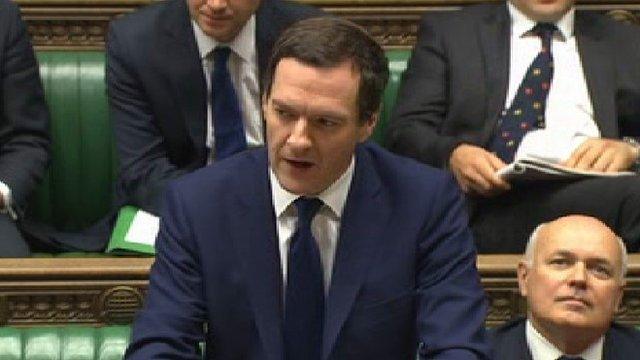Why is it hard to make 1% cuts?
- Published

The chancellor announced today that Whitehall departments have found £3bn of savings this financial year, which is equivalent to around 3% of unprotected departmental spending this year.
During the election campaign, David Cameron talked about how the government needs to save £1 from every £100 it spends - so 3% should put it well ahead of where it needs to be.
Unfortunately, it's not that simple. Today's announcement highlights why that 1% cuts figure was not entirely helpful.
The first problem is that things get more expensive, even at a time when the official measure of inflation is negative.
The National Health Service gets more expensive every year because the population is growing and ageing and because as medical science advances there are more things that can be treated.
Indeed, the government has promised an extra £8bn above inflation to the NHS by 2020, which will presumably have to be made up through further cuts in other departments.
Education spending is protected for children aged five to 16 in terms of cash per pupil, so rising pupil numbers would also need to be made up for by cuts elsewhere.
And international aid is protected and will rise in line with the amount the economy grows.
Unprotected departments
There are other areas of spending that the government will struggle to cut. Although the amount it is borrowing each year is falling, the total amount it has borrowed is still increasing, which means interest must be paid on more money, albeit at a very low interest rate.
The cost of public sector pensions keeps growing as more public sector workers retire and live longer.
And the state pension is triply protected, rising by inflation, wages or 2.5%, whichever is the higher.
To deal with all this, the government is planning to cut £12bn from the welfare bill and save £5bn by cutting back on tax avoidance, but most of the rest comes from cutting spending in unprotected departments. And 3% cuts would not be enough.
The Institute for Fiscal Studies reckons that the current plans to cut spending by 1% for the next two years and then freeze it for a third will actually mean cuts for unprotected departments averaging 5.4% a year for three years.
Which is not to say that the government will not be able to achieve such cuts. The last government was fairly successful at achieving the cuts it targeted, although it may be a bit harder this time because any easy cuts have presumably already been made and this government has a relatively small majority if any of its cuts are controversial on the backbenches.
But it is important to distinguish between the 1% figure we heard during the election and the 3% we heard today.